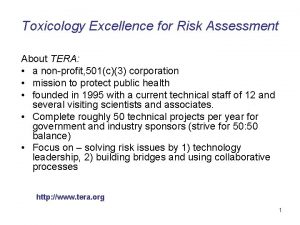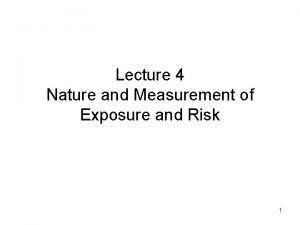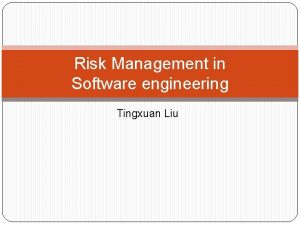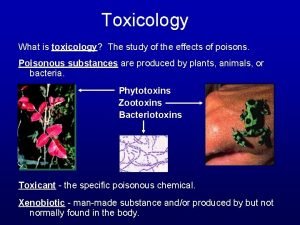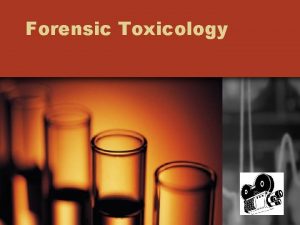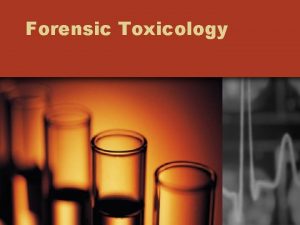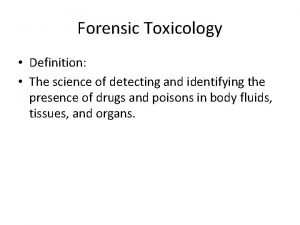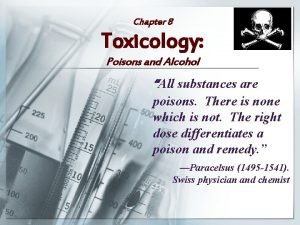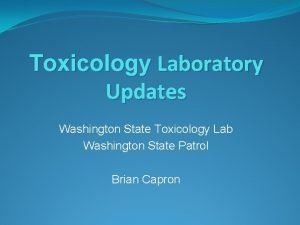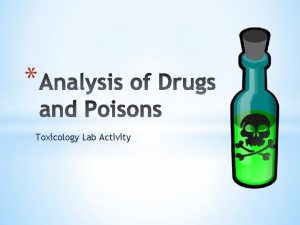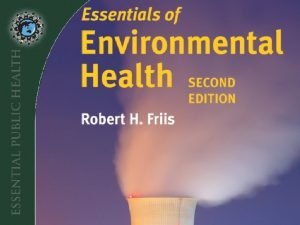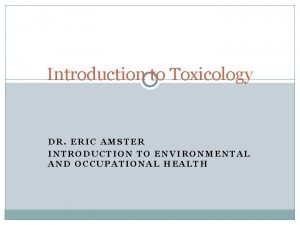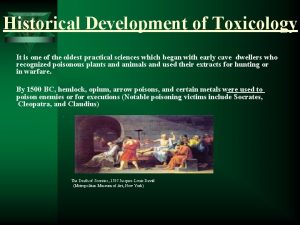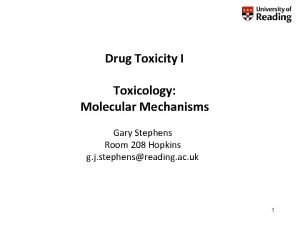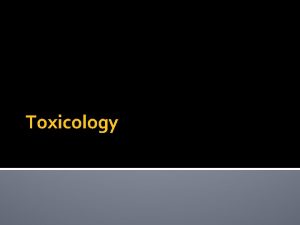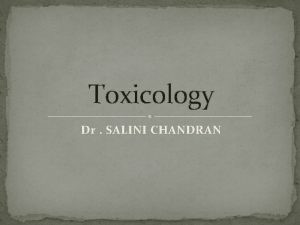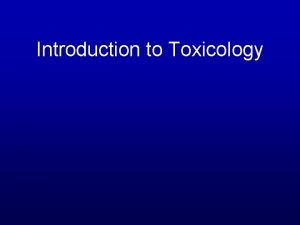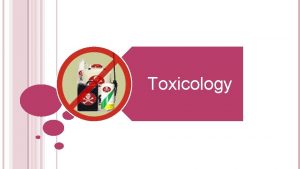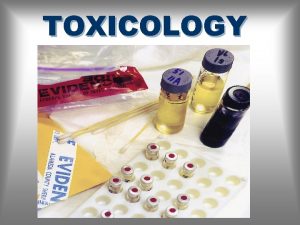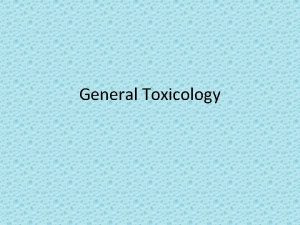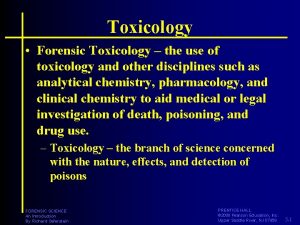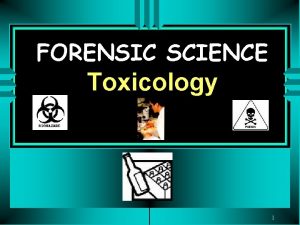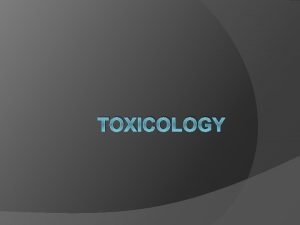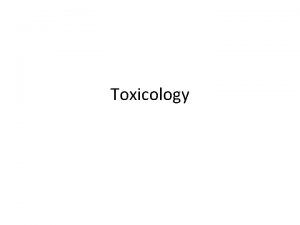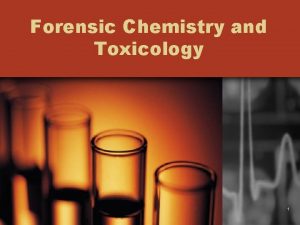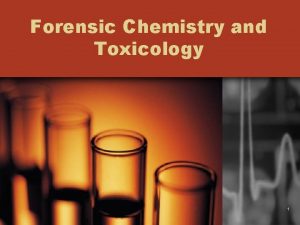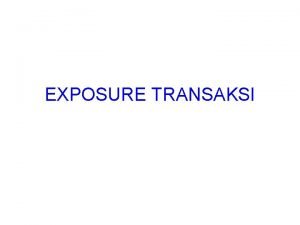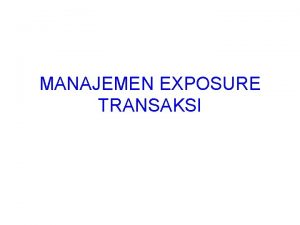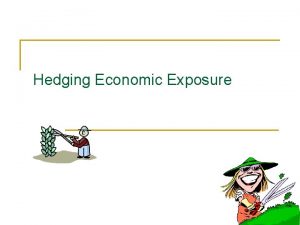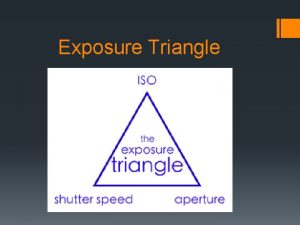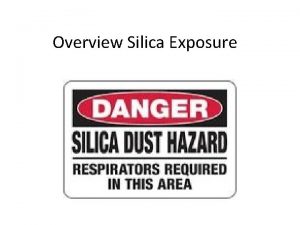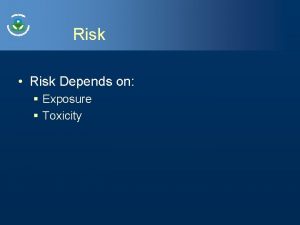Green Chemistry Toxicology Risk equation Risk fHazard Exposure



























- Slides: 27

Green Chemistry Toxicology

Risk equation Risk = f(Hazard, Exposure)

What is Toxicology? The traditional definition of toxicology is "the science of poisons. " A more descriptive definition of toxicology is "the study of the adverse effects of chemicals or physical agents on living organisms".

What Counts as Toxic?

Definitions A toxic agent is anything that can produce an adverse biological effect. It may be chemical, physical, or biological in form. For example, toxic agents may be • chemical (such as cyanide), • physical (such as radiation) and • biological (such as snake venom).

Dose is the amount of a substance administered at given times. For example: • 650 mg Tylenol as a single dose • 500 mg Penicillin every 8 hours for 10 days • 10 mg DDT per day for 90 days

The Dose Makes the Poison An apparently nontoxic chemical can be toxic at high doses. (Too much of a good thing can be bad) Highly toxic chemicals can be life saving when given in appropriate doses.

Approximate Lethal Doses of Common Chemicals (Calculated for a 160 lb. human from data on rats) Chemical Lethal Dose Sugar (sucrose) 3 quarts Alcohol (ethyl alcohol) 3 quarts Salt (sodium chloride) 1 quart Herbicide (2, 4 -D) one half cup Arsenic (arsenic acid) 1 -2 teaspoons Nicotine one half teaspoon Food poison (botulism) microscopic Source: Marczewski, A. E. , and Kamrin, M. Toxicology for the citizen, Retrieved August 17, 2000: www. iet. msu. edu/toxconcepts. htm.

What types of toxicities are there?

Categories of Toxicity: Acute • Acute toxicity occurs almost immediately (hours/days) after an exposure. • An acute exposure is usually a single dose or a series of doses received within a 24 hour period. • Death is a major concern in cases of acute exposures.

Categories of Toxicity: Chronic • With repeated exposures or long-term continual exposure, the damage from these subclinical exposures slowly builds-up (cumulative damage) until the damage exceeds the threshold for chronic toxicity.

Categories of Toxicity: Chronic • Examples of chronic toxic affects are: – chronic kidney disease in workmen with several years exposure to lead – chronic bronchitis in long-term cigarette smokers – pulmonary fibrosis in coal miners (black lung disease)

Categories of Toxicity: • Carcinogenicity is a complex multistage process of abnormal cell growth and differentiation which can lead to cancer. At least two stages are recognized. They are initiation in which a normal cell undergoes irreversible changes and promotion in which initiated cells are stimulated to progress to cancer. Chemicals can act as initiators or promoters. Carcinogenicity

Categories of Toxicity: Endocrine Disruption • Hormones: Chemical signaling – Reproduction – Growth – Kidney Function – Cardiac Function

Categories of Toxicity: Reproductive • Estrogenic compounds – DDT (pesticide) – Nonylphenols (detergents) – Bisphenol A (plastic liners)

Fundamental Rules of Toxicology 1. Exposure must first occur for the chemical to present a risk. 2. The magnitude of risk is proportional to both the potency of the chemical and the extent of exposure. 3. “The dose makes the poison” - amount of chemical at the target site determines toxicity.

Types of Toxic Effects Death - arsenic, cyanide Organ Damage - ozone, lead Mutagenesis - UV light Carcinogenesis - benzene, asbestos Teratogenesis - thalidomide

Factors Affecting Chemical Toxicity • • • form and inherent chemical activity dosage, especially dose-time relationship exposure route ability to be absorbed metabolism rate distribution within the body excretion rate presence of other chemicals species

Dose-Response The dose-response relationship is a fundamental and essential concept in toxicology. It correlates exposures and the spectrum of induced effects. The dose-response relationship is based on observed data from experimental animal, human clinical, or cell studies.

Dose-Response Knowledge of the dose-response relationship: • establishes causality that the chemical has in fact induced the observed effects • establishes the lowest dose where an induced effect occurs - the threshold effect • determines the rate at which injury builds up the slope for the dose response.

Variance in Population Susceptibility As demonstrated above, a graph of the individual responses can be depicted as a bell-shaped standard distribution curve.

Dose Estimates of Toxic Effects A common dose estimate for acute toxicity is the LD 50 (Lethal Dose 50%). This is a statistically derived dose at which 50% of the individuals will be expected to die.


Dose-Response Curve Characteristics Knowledge of the shape and slope of the dose-response curve is extremely important in predicting the toxicity of a substance at specific dose levels.

Dose-Response Curve Slope Knowledge of the slope is important in comparing the toxicity of various substances. For some toxicants a small increase in dose causes a large increase in response (toxicant A, steep slope). For other toxicants a much larger increase in dose is required to cause the same increase in response (toxicant B, shallow slope).

Conceptual shifts Old… only high levels matter New… impacts at everyday levels… …levels people had become accustomed to calling “normal, ” background levels… …levels that couldn’t even be measured 20 yrs ago.

Low levels matter: Arsenic At high levels… arsenic kills people At moderately low levels… it causes a range of diseases At truly low levels … it hijacks gene expression
 Managing economic exposure and translation exposure
Managing economic exposure and translation exposure Translation exposure
Translation exposure Economic exposure refers to
Economic exposure refers to Managing economic exposure and translation exposure
Managing economic exposure and translation exposure Green green green red
Green green green red Tera toxicology
Tera toxicology Varieb
Varieb Nature of exposure and risk
Nature of exposure and risk Risk exposure in software engineering
Risk exposure in software engineering Credit risk market risk operational risk
Credit risk market risk operational risk Xenobiotics definition
Xenobiotics definition Leone lattes contribution to forensic science
Leone lattes contribution to forensic science Define forensic toxicology
Define forensic toxicology Definition of forensic toxicology
Definition of forensic toxicology Forensics toxicology definition
Forensics toxicology definition Define environmental toxicology
Define environmental toxicology Chapter 8 toxicology poisons and alcohol
Chapter 8 toxicology poisons and alcohol Chapter 8 toxicology poisons and alcohol
Chapter 8 toxicology poisons and alcohol Toxicology management
Toxicology management Washington state toxicology lab
Washington state toxicology lab Forensic toxicology lab activity
Forensic toxicology lab activity Toxicology definition
Toxicology definition Toxicology and applied pharmacology
Toxicology and applied pharmacology North carolina medical examiner
North carolina medical examiner Toxicology
Toxicology Examples of toxicology
Examples of toxicology Toxicology
Toxicology Toxicology
Toxicology





